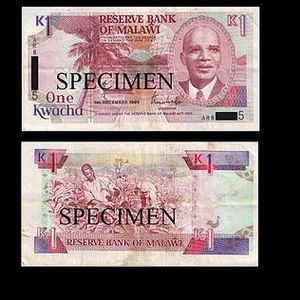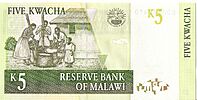Malawian kwacha facts for kids
Quick facts for kids Malawian kwacha |
|||||
|---|---|---|---|---|---|
|
|||||
| ISO 4217 Code | MWK | ||||
| User(s) | |||||
| Inflation | 19.90% | ||||
| Source | Rbm Nov 2016 | ||||
| Subunit | |||||
| 1⁄100 | tambala | ||||
| Symbol | K | ||||
| Coins | |||||
| Freq. used | 1, 5, 10 kwacha | ||||
| Rarely used | 1, 2, 5, 10, 20, 50 tambala | ||||
| Banknotes | 20, 50, 100, 200, 500, 1,000, 2,000, 5,000 kwacha | ||||
The kwacha is the official money used in Malawi, a country in Africa. It was first introduced in 1971. Before the kwacha, Malawi used the Malawian pound.
One kwacha is made up of 100 smaller units called tambala. The Reserve Bank of Malawi is in charge of printing and issuing the kwacha banknotes. Sometimes, the value of the kwacha changes compared to other countries' money. For example, in 2012, its value dropped quite a bit. More recently, in 2022 and 2023, its value also changed, which affected prices in Malawi.
Contents
What Does "Kwacha" Mean?
The name kwacha comes from a local language called Chinyanja or Chichewa. It means "it has dawned" or "it is morning". This name was first used for the money in Zambia in 1968.
The word tambala also comes from the Chichewa language. It means "rooster". It got this name because a hundred roosters crowing announce the dawn. This connects nicely with "kwacha" meaning "it has dawned".
A Brief History of Malawi's Money
The kwacha took over from the Malawian pound in 1971. When this happened, two kwacha were worth the same as one pound.
Before the kwacha, Malawi used different types of money. These included the British pound sterling, the South African rand, and the Rhodesian dollar. The kwacha helped Malawi have its own unique currency.
The value of the kwacha used to be set by the government. But since 1994, its value has been allowed to "float". This means its value can change based on how much people want to buy or sell it.
Coins of Malawi
The first kwacha coins were made in 1971. They came in small values like 1, 2, 5, 10, and 20 tambala. Later, in 1986, larger coins of 50 tambala and 1 kwacha were added.
In 2007, even bigger coins were introduced: 5 and 10 kwacha. Then, in 2012, new 1, 5, and 10 kwacha coins were put into circulation.
The coins are made from different metals. For example, the 1 and 2 tambala coins are made of steel with a copper coating. The 5 tambala coin is steel with a nickel coating. The 50 tambala and 1 kwacha coins are steel with a brass coating.
Banknotes of Malawi
Banknotes are the paper money. In 1971, the first kwacha banknotes were released. They included values like 50 tambala, 1, 2, and 10 kwacha. Over the years, new banknotes were added and some old ones were stopped.
For example, 5 kwacha notes came out in 1973, and 20 kwacha notes in 1983. The 50 tambala and 1 kwacha notes were last printed in the late 1980s and early 1990s.
Higher value notes were introduced as time went on. These included 50 kwacha in 1993, 100 kwacha in 1993, 200 kwacha in 1995, and 500 kwacha in 2001. A 2000 kwacha note was added in 2016 to help with cash shortages.
Banknote Series (1997)
Here are some of the banknotes that were in use around 2008, from the 1997 series:
| 1997 Series | ||||||
|---|---|---|---|---|---|---|
| Image | Value | Dimensions | Main Colour | Description | Date of first printing | |
| Obverse | Reverse | |||||

|
K5 | 126 × 63 mm | Green | John Chilembwe | Villagers mashing grain | 1 July 1997 |
| K10 | 132 × 66 mm | Brown | Children in "bush" school | |||
| K20 | 138 × 69 mm | Purple | Workers harvesting tea leaves | |||
| K50 | 144 × 72 mm | Blue | Independence Arch in Blantyre | |||
| K100 | 150 × 75 mm | Red | Capital Hill in Lilongwe | |||
| K200 | 156 × 78 mm | Blue | Reserve Bank building in Lilongwe | |||
| K500 | 162 × 81 mm | Multi-colour | Reserve Bank building in Blantyre | 1 December 2001 | ||
New Banknote Series (2012)
In 2012, the Reserve Bank of Malawi introduced a brand new series of banknotes. These new notes were smaller than the older ones, which helped save money on printing. A new 1,000 kwacha note was also added, becoming the largest value note at the time.
The new 1,000 kwacha note featured the face of Malawi's first president, Hastings Banda, on the front. On the back, it showed maize silos in Mzuzu, representing an important crop for the country.
There was a small mistake found on the new 20 kwacha note. The building shown on the back was supposed to be the Domasi Teacher's Training College, but it was actually the Machinga Teacher's Training College.
The Reserve Bank also planned to make the new notes more "blind friendly". This means making them easier for people who are visually impaired to tell apart.
| 2012 Series | ||||||
|---|---|---|---|---|---|---|
| Image | Value | Dimensions | Main Colour | Description | Date of first printing | |
| Obverse | Reverse | |||||
 |
K20 | 128 × 64 mm | Purple | Reserve Bank of Malawi headquarters in Lilongwe; Inkosi ya Makhosi M’mbelwa II (Lazalo Mkhuzo Jere) | Domasi Teachers Training College building and tree; stack of books and mortarboard | 23 May 2012 |
 |
K50 | 128 × 64 mm | Light blue and green | Reserve Bank of Malawi headquarters building in Lilongwe; Inkosi Ya Makhosi Gomani II (Philip Zitonga Maseko) | Elephants, tree, and safari vehicle in Kasungu National Park | |
 |
K100 | 128 × 64 mm | Red | Reserve Bank of Malawi headquarters building in Lilongwe; James Frederick Sangala | College of Medicine in Blantyre; stethoscope | |
 |
K200 | 132 × 66 mm | Blue and violet | Reserve Bank of Malawi headquarters building in Lilongwe; Rose Lomathinda Chibambo | New Parliament building in Lilongwe | |
 |
K500 | 132 × 66 mm | Brown and orange | Reserve Bank of Malawi headquarters building in Lilongwe; Reverend John Chilembwe | Mulunguzi dam in Zomba; water spigot; silhouette of woman carrying container on head and man carrying hoe over shoulder | |
 |
K1000 | 132 × 66 mm | Green | Reserve Bank of Malawi headquarters building in Lilongwe; Dr. Hastings Kamuzu Banda | Mzuzu maize silos; stalk of maize (corn); silhouette of two people mashing maize | |
 |
K2000 | Yellow | Reverend John Chilembwe; outline of Malawi | Malawi University of Science and Technology, Thyolo District | 1 June 2016 | |
Newer Banknote Series (2022)
In 2022, even newer banknotes were released, including higher values like the 2000 kwacha and 5000 kwacha notes.
| 2022 Series | ||||||
|---|---|---|---|---|---|---|
| Image | Value | Dimensions | Main Colour | Description | Date of first issue | |
| Obverse | Reverse | |||||
| K2000 | 135 × 66 mm | Orange | Reverend John Chilembwe; outline of Malawi | Blantyre Magistrate Court | 24 February 2022 | |
| K5000 | Purple | Dr. Hastings Kamuzu Banda; outline of Malawi | Reserve Bank of Malawi central office, Blantyre | 24 February 2022 | ||
| Current MWK exchange rates | |
|---|---|
| From Google Finance: | AUD CAD CHF EUR GBP HKD JPY USD ZAR EUR JPY |
| From Yahoo! Finance: | AUD CAD CHF EUR GBP HKD JPY USD ZAR EUR JPY |
| From XE.com: | AUD CAD CHF EUR GBP HKD JPY USD ZAR EUR JPY |
| From OANDA: | AUD CAD CHF EUR GBP HKD JPY USD ZAR EUR JPY |
| From fxtop.com: | AUD CAD CHF EUR GBP HKD JPY USD ZAR EUR JPY |
See also
- Economy of Malawi
- Zambian kwacha






